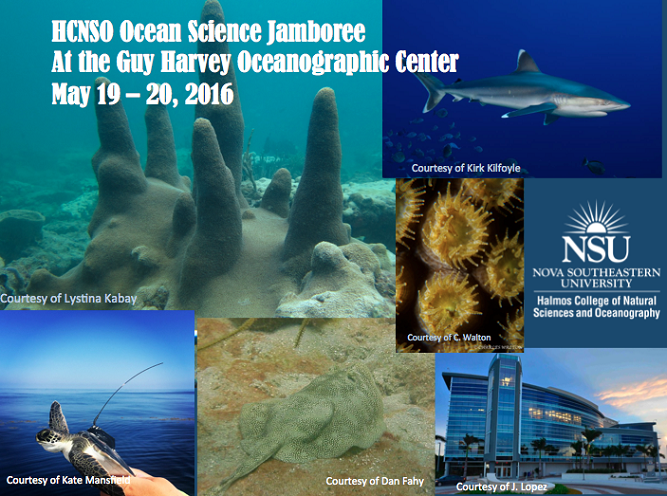Why stop at the surface when addressing marine ecosystems? A preliminary assessment of trophic positions for the seabirds of south Florida using C and N stable isotopes
Location
Guy Harvey Oceanographic Center Facility
Start
5-20-2016 2:30 PM
End
5-20-2016 2:45 PM
Abstract
Seabirds outside the Northeast Pacific and Northeast Atlantic regions are poorly understood from a trophic perspective. To elucidate trophic level relationships, we examined the concentration of ∂13C and ∂15N in the blood, breast muscle, and feathers (proximal and distal sections) of nine species of adult marine-associated birds commonly found in South Florida: osprey Pandion haliaetus (n=1), black skimmer Rynchops niger (n=1), brown pelican Pelecanus occidentalis (n=36), northern gannet Morus bassanus (n=19), double-crested cormorant Phalacrocorax auritus (n=22), royal tern Thalasseus maximus (n=7), herring gull Larus argentatus (n=5), laughing gull Leucophaeus atricilla (n=11), and ring-billed gull Larus delawarensis (n=3). We collected specimens from four wildlife rehabilitation centers after death due to trauma or illness; specimens were frozen at the respective centers and dissected in the laboratory. Three centers (Broward and Dade counties) were in mainland-coastal areas, while one (Monroe county; Florida Keys) was in a coastal-island environment. Tissues were compared between species and tissue types to determine patterns of ∂13C and ∂15N enrichment. Calculated mean trophic levels (TLs) of all study species ranged from 5.15 (osprey and northern gannet) to 3.64 (ring-billed gull), findings consistent with existing diet information, and all species exhibited expected ∂13C:∂15N ratios. Broadly varying, but consistent, relationships were seen between tissues, with blood:feather comparisons showing the largest differences. Herring and laughing gulls (TL 4.59 and 3.90, respectively) appear to have a straight trophic enrichment based on coastal POM, although perhaps influenced by occasional anthropogenic waste. Northern gannets (TL 5.15) are likely consuming a limited diet in offshore areas consistent with POM-based enrichment patterns and feeding strategies. Brown pelicans, osprey, and royal terns (TLs 4.78, 5.15, and 4.11, respectively) overlap diets when in the South Florida region, likely reflecting feeding areas; consistent with field observations, when onshore winds are strong, these species feed inshore on carbon-enriched prey, but when winds are weak, they feed near/offshore on carbon-depleted prey, such as lipid-rich fishes. However, cormorants (TLs 3.40 to 5.59) appear to have an unusally bifurcated ∂13C and ∂15N signal between specimens, apparently representing the two habitats inhabited by individual birds in South Florida: one along the coastal/nearshore ecotone (Monroe county) and one along the inland/coastal ecotone (Dade and Broward counties).
Why stop at the surface when addressing marine ecosystems? A preliminary assessment of trophic positions for the seabirds of south Florida using C and N stable isotopes
Guy Harvey Oceanographic Center Facility
Seabirds outside the Northeast Pacific and Northeast Atlantic regions are poorly understood from a trophic perspective. To elucidate trophic level relationships, we examined the concentration of ∂13C and ∂15N in the blood, breast muscle, and feathers (proximal and distal sections) of nine species of adult marine-associated birds commonly found in South Florida: osprey Pandion haliaetus (n=1), black skimmer Rynchops niger (n=1), brown pelican Pelecanus occidentalis (n=36), northern gannet Morus bassanus (n=19), double-crested cormorant Phalacrocorax auritus (n=22), royal tern Thalasseus maximus (n=7), herring gull Larus argentatus (n=5), laughing gull Leucophaeus atricilla (n=11), and ring-billed gull Larus delawarensis (n=3). We collected specimens from four wildlife rehabilitation centers after death due to trauma or illness; specimens were frozen at the respective centers and dissected in the laboratory. Three centers (Broward and Dade counties) were in mainland-coastal areas, while one (Monroe county; Florida Keys) was in a coastal-island environment. Tissues were compared between species and tissue types to determine patterns of ∂13C and ∂15N enrichment. Calculated mean trophic levels (TLs) of all study species ranged from 5.15 (osprey and northern gannet) to 3.64 (ring-billed gull), findings consistent with existing diet information, and all species exhibited expected ∂13C:∂15N ratios. Broadly varying, but consistent, relationships were seen between tissues, with blood:feather comparisons showing the largest differences. Herring and laughing gulls (TL 4.59 and 3.90, respectively) appear to have a straight trophic enrichment based on coastal POM, although perhaps influenced by occasional anthropogenic waste. Northern gannets (TL 5.15) are likely consuming a limited diet in offshore areas consistent with POM-based enrichment patterns and feeding strategies. Brown pelicans, osprey, and royal terns (TLs 4.78, 5.15, and 4.11, respectively) overlap diets when in the South Florida region, likely reflecting feeding areas; consistent with field observations, when onshore winds are strong, these species feed inshore on carbon-enriched prey, but when winds are weak, they feed near/offshore on carbon-depleted prey, such as lipid-rich fishes. However, cormorants (TLs 3.40 to 5.59) appear to have an unusally bifurcated ∂13C and ∂15N signal between specimens, apparently representing the two habitats inhabited by individual birds in South Florida: one along the coastal/nearshore ecotone (Monroe county) and one along the inland/coastal ecotone (Dade and Broward counties).


